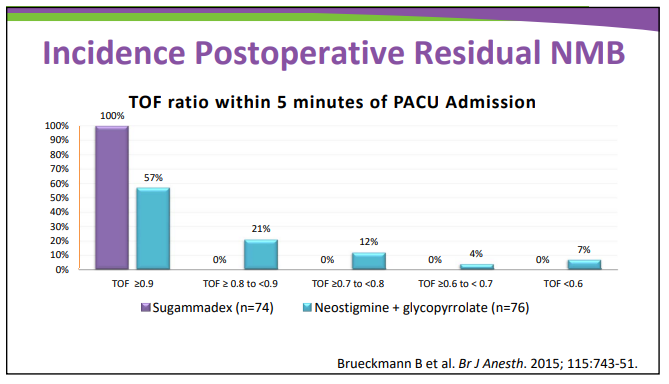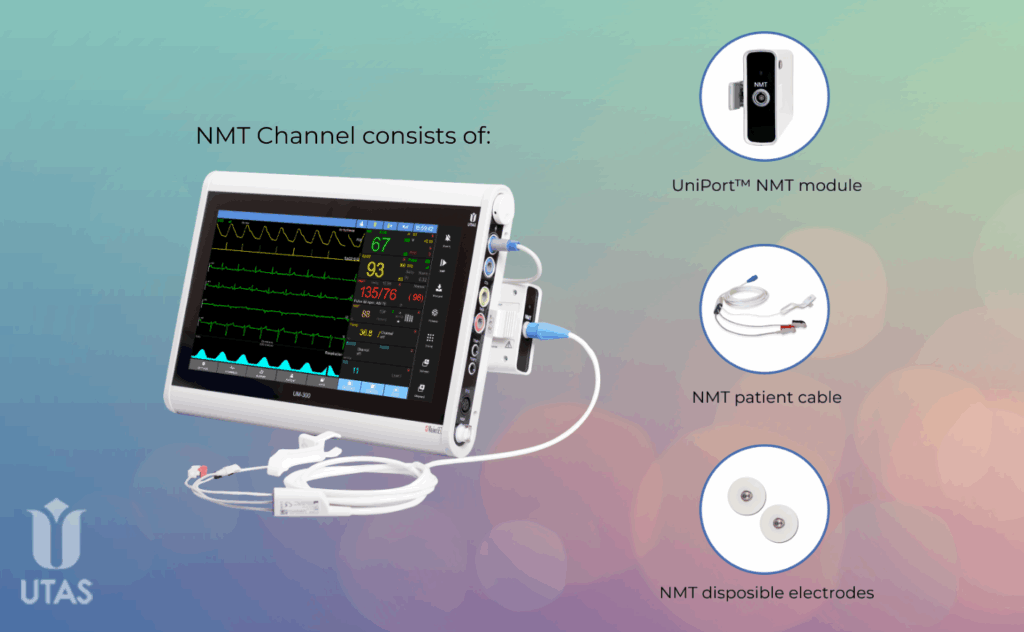
Continuous Confidence in the OR: Neuromuscular Monitoring with NMT in UM 300-S
Despite advances in anesthesia, residual neuromuscular blockade (RNMB) remains a relevant clinical concern — increasing the risk of respiratory complications and delaying recovery. Continuous and quantitative assessment of neuromuscular transmission (NMT) is the most effective way to avoid RNMB. With the UM 300-S patient monitor, you can easily add NMT monitoring as part of the extended module set — without any software upgrades.
UTAS is proud to integrate an NMT module from the technology of the ToFscan, manufactured by IDMED which is a French company among one of the global leaders in neuromuscular blockade monitoring. It is a quantitative and objective stim monitor for neuromuscular transmission using the three-dimensional acceleromyography technique (3D-AMG).
What is Neuromuscular Transmission (NMT) Monitoring
It accurately measures a patient’s neuromuscular blockade level. The UTAS NMT module replaces visual and tactile assessment to prevent residual neuromuscular blockade (RNMB).
The full set of stimulation modes includes: TOF (Train-of-Four), TET (Tetanus), PTC (Post-Tetanic Count), ST (Single Twitch), DBS (Double Burst Stimulation), and ATP (Automatic TOF/PTC sequence).
The estimated incidence of residual neuromuscular blockade after intermediate-acting agents (like rocuronium, vecuronium) remains high: 20–40%, even after short procedures.[1]

Achieving a TOF ratio of ≥ 0.9–0.95 is associated with improved respiratory function, smoother awakening, and better patient comfort in recovery.[2]
Easy to use, especially in automated modes (Auto-TOF and ATP), the UTAS NMT module is reliable, mobile, and cost-effective. It can be used anytime, even on already paralyzed patients, providing monitoring with confidence through TOF and PTC modes.
The anatomically designed splint (Hand-Thumb sensor – ulnar nerve) allows fast, precise, and reproducible positioning. Preloading ensures accurate and reliable measurements. The sensor is reusable, ensuring cost efficiency, and allows quick integration in ICU or OR without calibration. The silicone splint design guarantees consistent and reliable results.
The ToFscan is being used worldwide in both operating rooms and ICUs:
Applications of NMT in surgery
• With every patient on non-depolarizing/depolarizing neuromuscular blocking drugs
• Even on already paralysed patients (no calibration is required)
• At the beginning of surgery to know when to intubate
• To maintain the desired level of blockade during surgery
• Carrying out antagonisation
• At the end of surgery to know when it is safe to extubate and avoid any residual block
Application of NMT in ICU
• Maintaining the desired level of block and control recovery for intubated patients.
NMT in UM 300-S Patient Monitor
The NMT module based on ToFscan® technology is integrated into the flexible UniPort™ modular system of the UM 300-S patient monitor. It can be added at any stage of use and works seamlessly alongside other anesthesia tools — such as BIS™, AAg, and EtCO₂ — as part of the extended set for anesthesiology.

Setting up NMT is fast and intuitive: when module is recognized automatically (plug-n-play), clinician can select stimulation parameters (TOF, PTC, or Auto ATP), and immediately get a quantitative and objective result of the level of neuromuscular blockade of the patient. All readings are automatically recorded in the anesthesia record with trends, events, and PDF export for documentation and analysis.
As a part of modern anesthesia monitoring, NMT can significantly enhance patient safety. It enables clinicians to individualize NMBA dosing, avoid under- or overdosing, and ensure timely recovery. Objective, real-time neuromuscular assessment helps reduce complications and can improve outcomes. Integrating NMT monitoring should become a standard of care — and with the UM 300-S, it’s simpler than ever to make it part of routine practice.
1. ASHP. Neuromuscular Blockade Safety: Optimizing Monitoring and Reversal. Medication Safety Collaborative, 2018. PDF
2. Brull SJ, Kopman AF. Neuromuscular Monitoring: An Update for the 21st Century Anesthesiologist. Curr Anesthesiol Rep. 2023. doi: 10.1007/s40140-023-00581-1



